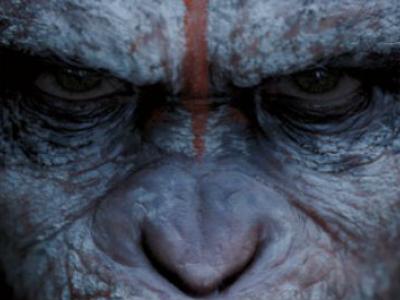
Dawn of the Planet of the Apes is not your average Summer Blockbuster. Sure, it’s got explosions, monkeys on horseback dual wielding machine guns, and a very simple plotline; but it also has so much more than that. It has beautiful character moments that would usually hit the cutting room floor, a better standard of acting in the motion caption performances than you’ll see in many blockbusters, and a reflection on the dangers of institutionalised fear, hatred and mistrust.
The film is set ten years on from the events of Rise of the Planet of the Apes and humanity has been all but wiped out by the Simian Flu. Caesar is now head of a growing nation of apes and has built a home for his community in the Muir Woods outside San Francisco. We see the beginnings of the caste system from Planet of the Apes, and see that the tenets of Ape law have been established.
This community is threatened after a chance encounter with a group of surviving humans who wander into the woods. This encounter leads to the discovery of a larger group of human survivors holed up in the city, who need access to a dam deep in Ape territory to try and restore power to their sanctuary.
It is upon this plot device that the film bases much of its human vs ape interaction, and through it develops a genuine feeling of rising tension and drama. Uneasy alliances form and Caesar becomes a beleaguered leader, persistently counseling for peace even in the face of calls to war from his friend and General, an ape named Koba who was mercilessly experimented on and tortured by humans in the pre-Rise era.
That you feel for Caesar, as he is burdened with trying to do the right thing in the face of the inevitability of mob rule, is all down to the incredible performance from Andy Serkis. I really cannot praise the motion capture performances enough. They make you care about the apes, and they bring you into their world with subtle and nuanced performances that help you suspend disbelief entirely.
One of the most striking things for me was how the typical movie tropes of father and son reconciliation/redemption arcs, enemy become ally story arcs, and final confrontations; just seemed more real here. Lines and interactions that would have seemed cheesy in a normal film with human actors, just seemed to fit better and feel more genuine when one of the characters was a CGI Ape. This is due, in no small part, to the connection that performances create with the audience. So again, kudos to the motion capture team.
Not to be outdone by their CGI counterparts, there was also some great acting from the human cast as well. This was a major improvement on “Rise” which, aside from John Lithgow, I felt was pretty weak on the acting front.
The film isn’t without its weaknesses though, and I felt that the pacing could have been improved a little. The film could have been 10 minutes shorter and not really lost anything from the narrative. Also, the ending wasn’t as fulfilling as I would have liked, and makes it feel a little like a place holder, second installment film in an inevitable trilogy. I’d expect to hear a “War for the Planet of the Apes”, or similar title, to be announced fairly soon.
I can live with these negatives though given that the rest of the film is really very good indeed. Recommended viewing for those who want more from their summer blockbuster movies.

